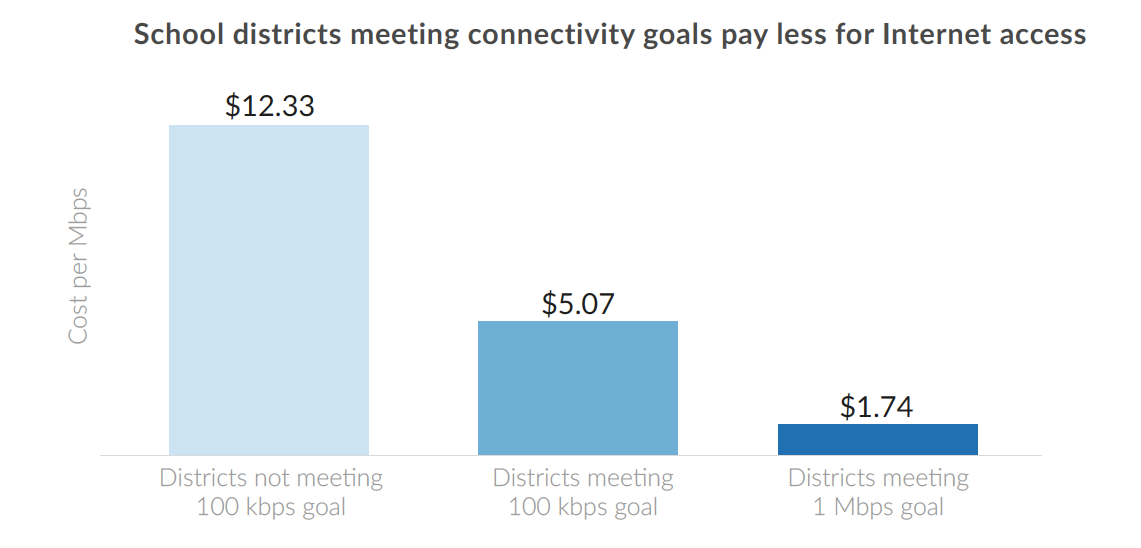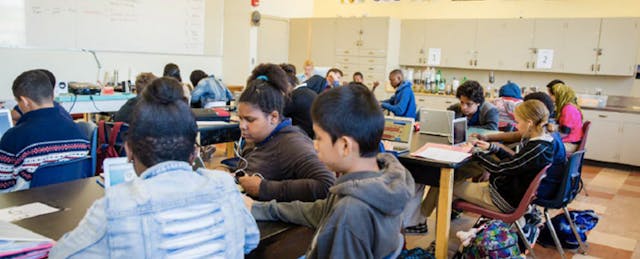Two years ago, more than 40 million US students could barely stream online videos. Only 30 percent of K-12 districts provided sufficient Internet access speed to support digital learning, defined by the Federal Communications Commission (FCC) at 100 kbps per student.
Today, that number has been slashed nearly in half, with 20 million more students enjoying Internet speeds that meet the FCC’s goal. A new report, “2015 State of the States,” published by San Francisco-based nonprofit by EducationSuperHighway, found that 77 percent of school districts have hit the target speed. In all, an estimated 24.5 million students and 1.7 million teachers now enjoy enough broadband to make the most out of education technology tools.
Researchers collected data from 6,781 public school districts across the nation, representing over 25 million students across approximately 49,000 schools.

“It’s surprising the amount of progress we did in the last two years,” says Evan Marwell, founder and CEO of EducationSuperHighway.
Since its founding in 2012, the nonprofit has directed research and advocacy efforts to help schools and districts lay the proper infrastructure to support digital learning technologies. Its very first task: ask schools across the country to take an Internet “speed test” to see how fast—or slow—their connections were. EducationSuperHighway’s efforts quickly attracted the attention—and over $29 million—from groups including the Gates Foundation and Startup:Education, the philanthropy founded by Mark Zuckerberg.
EducationSuperHighway’s work has been timely, coinciding with growing political support for better bandwidth access. In 2013, President Obama announced the ConnectED Initiative and an ambitious objective to connect 99 percent of America’s students to next-generation broadband and wireless network. Other politicians are paying heed. According to the report, 38 governors “are committed to finishing the job of upgrading their schools and leading the way by taking state-level action,” which includes committing tens of millions of dollars to infrastructure upgrades.
Despite the political support and current progress made, over 21 million students—roughly the size of the population of metropolitan New York—still lack adequate Internet access. Even more worrisome is that the FCC has set a goal for all districts to provide 1 Mbps per student—ten times the current target of 100 kbps—by 2018.
There are valid reasons for raising the bar: “In schools using digital learning, bandwidth demand is growing at a rate of 50% or more per year,” finds the report’s authors. A district that uses technology frequently, they estimate, will have to triple its bandwidth in the next three years. Researchers from the Consortium of School Networking also estimate that bandwidth demand may increase by as much as 60 percent each year.
Today, only nine percent of districts are meeting this goal. But don’t worry too much yet, says Marwell. “One megabit per student is probably more than schools need now. It would be a waste if schools offer that connectivity when the demand is still lower.”
Action Plans
What’s holding schools back? An estimated 9,500 of them still lack fiber, “the only commercially available technology that is scalable enough to support the projected bandwidth needs for the vast majority of school districts,” according to the report. These efforts require investments: districts that currently provide 100 Mbps of connectivity per student invest nearly $5 per student per year from their budgets—more than twice as much as districts that do not meet the target.
However, one opportunity that many districts still leave untapped is E-Rate, a fund (supported by a surcharge on the public’s phone and Internet bills) that subsidizes the cost of telecommunication services to schools and libraries. On average, EducationSuperHighway estimates that E-rate can cover 70 percent of connectivity costs. In 28 states, more than half of districts are accessing this money.
Doing market research—especially where there are multiple Internet service providers—is essential to getting better rates, Marwell recommends. The report finds major variance in how much districts are paying for the same level for service. The monthly cost for a 100 Mbps connection can range from ranges from $504 to $3,625; for 10 Gbps service, the difference can be more than twelve-folds.

One reason for these price differences, suggests Marwell, is that districts often don’t know how much they should be paying. The report, he hopes, will equip them with the information to negotiate for fairer rates.
Marwell also encourages neighboring districts to band together when negotiating Internet rates. “The more you buy, the better price you’ll get,” says Marwell. The average cost per Mbps is $5.07 for districts that meet the FCC’s 100 Kbps per student goal; those not meeting the target pay $12.33.

He points to Virginia as one example where group purchasing led to lower prices. There, five districts realized that they were paying much more than they should and organized a consortium to renegotiate rates. As a result, they were able to quintuple their bandwidth for only a 15 percent increase in costs.

Much progress has been made, but it’s no reason to rest on the laurels, states Marwell. “This next 20 million will be harder than the last 20 million.” But a growing coalition private, political and public support leaves him optimistic.


